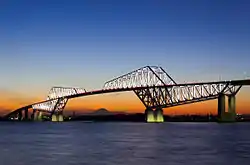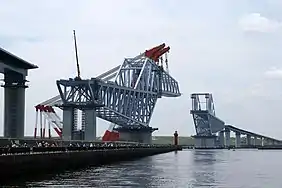Tokyo Gate Bridge
Tokyo Gate Bridge (東京ゲートブリッジ, Tōkyō gēto burijji) is a truss cantilever bridge across Tokyo Bay in Kōtō, Tokyo, Japan. It opened on 12 February 2012[1][2] with an estimated total construction cost of ¥113,000,000,000 (equivalent to ¥119,120,400,000 in 2019) for the Stage II section of highway including the bridge.[3] it is similar to those as Forth Bridge in UK and Quebec Bridge in Canada and Queensboro Bridge in New York City.
Tokyo Gate Bridge 東京ゲートブリッジ | |
|---|---|
 Tokyo Gate Bridge, January 2015 | |
| Coordinates | 35°36′41″N 139°49′38″E |
| Carries | Road traffic (4 lanes), pedestrians |
| Crosses | Tokyo Bay |
| Locale | Kōtō City (Tokyo, Japan), between Chubo and Wakasu artificial islands) |
| Characteristics | |
| Design | cantilever bridge |
| Total length | 2,618 metres (8,589 ft) including approaches |
| Width | 21 metres (69 ft) |
| Height | 87.8 metres (288 ft) |
| Longest span | 440 metres (1,440 ft) |
| No. of spans | 3 |
| Clearance below | 54.6 metres (179 ft) |
| History | |
| Construction start | 2002 |
| Construction end | 2011 |
| Opened | 2012 |
| Statistics | |
| Toll | None |
| Location | |
History
Part of a new four-lane highway ringing Tokyo, construction began in 2002 and was scheduled for completion in 2011, but the opening to traffic was delayed until 2012. With the provisional name of Tokyo Bay Waterfront Bridge (東京港臨海大橋, Tōkyōwan rinkai ōhashi)[4] the public was asked for suggestions. From the 12,223 received, "Tokyo Gate Bridge" was chosen and officially announced on 15 November 2010.[5]
Design
The design fulfils the requirement to be high enough to allow large ships to pass underneath, but low enough not to interfere with air traffic to the nearby Haneda Airport. It is a double cantilever bridge, which means that the truss sections from either side can be completed in balance, and then joined by the addition of the relatively short central span.[6] The resemblance of the bridge to two monsters facing off has given it the nickname of 'Dinosaur Bridge' (恐竜橋, Kyōryū-bashi)[7]
Gallery
 Tokyo Gate Bridge under construction (May 2010)
Tokyo Gate Bridge under construction (May 2010) The bridge as seen from the roadway
The bridge as seen from the roadway The main span of the bridge
The main span of the bridge Elevator system for sightseeing
Elevator system for sightseeing_001.jpg.webp) Tokyo port seen from the bridge
Tokyo port seen from the bridge
Others
Visitors can take an elevator to the sidewalk on this bridge and walk on the sidewalk from Wakasu to Central Breakwater. But, you can only take an elevator to the sidewalk and the ground from Wakasu Gate, because Central Breakwater Gate is closed, so you cannot take an elevator to sidewalk and ground from Central Breakwater.
If you want to only see the bridge, you go to Wakasu Seaside Park and Central Breakwater.
Access
You can use Wakasu Seaside Park Bus stop which 木31 - Shin-Kiba Station(Toei Bus) passes through. You can also use Central Breakwater Bus stop which 波01 - Tokyo Teleport Station(Toei Bus)passes through. ※From Central Breakwater gate you cannot walk on the bridge.
References
- "Stay in Tsukiji, see Tokyo Gate Bridge". The Japan Times. 24 February 2012. Retrieved 3 August 2016.
- "Tokyo Gate Bridge opens to traffic". Japan Today. 13 February 2012. Retrieved 3 August 2016.
- Official "flyer" shows Stage II including Tokyo Gate Bridge, with a budget as of November 2009 "東京港臨海道路II期事業の概要" [Tokyo Bay Waterfront Highway Stage II work overview] (PDF) (in Japanese). Japan: Ministry of Land, Infrastructure, Transport and Tourism. 2011. Archived (PDF) from the original on 5 January 2013. Retrieved 30 June 2012.
- Yoneyama, Haruo; Obara, Kouehei; Shigihara, Toru (2010). Plan and Design of 'The Rinkai Ohashi Bridge' in Tokyo Port (PDF). The 5th Civil Engineering Conference in the Asian Region and Australasian Structural Engineering Conference. pp. 203–208. ISBN 9780646537276. Retrieved 3 August 2016.
- 東京港臨海大橋(仮称)の名称決定について [Official name for Tokyo Bay waterfront bridge]. News Release (in Japanese). Japan: Tokyo Metropolitan Government. 15 November 2010. Archived from the original on 27 November 2010. Retrieved 30 June 2012.
- Official "flyer" updated with the top photo showing the central span being added. At the bottom is an illustration of the constraints from air and sea. "【最新版】TGBチラシ_H23.3.3_" [Tokyo Gate Bridge latest update 3 March 2011] (PDF) (in Japanese). Japan: Ministry of Land, Infrastructure, Transport and Tourism. 2011. Archived (PDF) from the original on 8 October 2011. Retrieved 6 June 2011.
- Cooper, Chris; Matsuda, Kiyotaka (12 February 2012). "'Dinosaur Bridge' leads Tokyo push to ease traffic and boost economy". The Japan Times. Bloomberg. p. 2. Archived from the original on 30 April 2013. Retrieved 3 August 2016.
External links
- Official Tokyo Metropolitan Government page about the bridge (in Japanese)
- Yoneyama, T.; Fujii, Y. (21–22 August 2015). Amin; Okui; Bhuiyan; Ueda (eds.). Fabrication and erection of Tokyo Gate bridge (PDF). IABSE-JSCE Joint Conferences on Advances in Bridge Engineering-III. Dhaka, Bangladesh. ISBN 978-984-33-9313-5. Retrieved 3 August 2016.
- Tokyo Gate Bridge at Structurae
- Johnstone, Sean; Kodama, Yoshifumi; Hata, Takanori (May 2010). "Tokyo triple" (PDF). Bridge Design & Engineering. 16 (59). Retrieved 3 August 2016.
- "15,000 enthusiasts participate in Tokyo Gate Bridge's Completion Commemoration Sports Festival". Tokyo 2020. 6 February 2012. Retrieved 3 August 2016.
- 東京ゲートブリッジ 下部トラス桁架設工事記録 (Erection of lower truss girder for Tokyo Gate Bridge) on YouTube